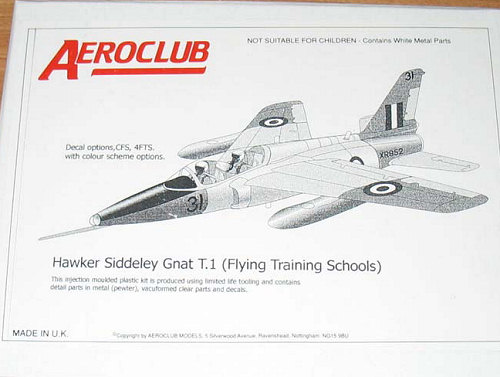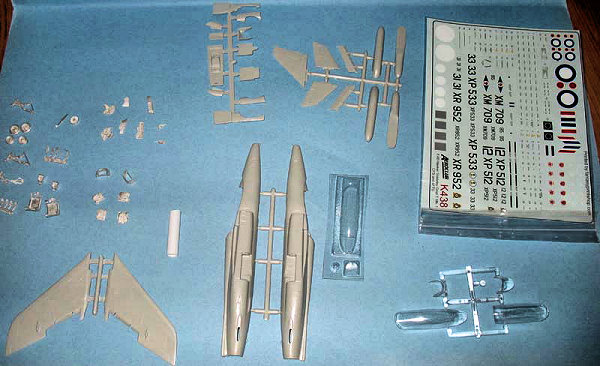
Aeroclub 1/48 Gnat T.1
| KIT: | Aeroclub 1/48 Gnat T.1 |
| KIT #: | ? |
| PRICE: | £26.50 (cheap it isn't) |
| DECALS: | Four Options |
| REVIEWER: | Dan Lee |
| NOTES: | Short Run kit with metal parts and vac canopy |

| HISTORY |
The Tiny Fighter that Could
William 'Teddy' Petter originally designed the Gnat as a rocket powered point defense fighter. As jet engines improved and became smaller and aircraft companies evaluated the jet vs jet Korean war experience, the design changed to an ultra lightweight maneuverable fighter (the exact opposite of what Lockheed design guru Kelly Johnson came up with in the F-104 Starfighter.)
India became the biggest user of the Gnat (or Ajeet) and the only nation to fly these in combat where they successfully took on Pakistanís F-86 Sabres. The Ajeet was known as the Sabre Killer.
Outside of India the Gnat T1 trainer was more known because it was the plane of the RAFís Red Arrows acrobatic team from the mid 60s till the late 70s when it was replaced by the BAE Hawk. It was the primary RAF jet trainer in that time frame and wore very colorful paint schemes such as aluminum/day glo orange and signal red/light grey and white.
Gnats are still flying around the world in private collections because it is a very simple jet to maintain and fly (like the early Migs.) The Gnat T1 was also became a movie star of sorts. They were in the Top Gun spoof (I think the Tom Cruise movie was parody enough) Hot Shots and Hot Shots Part Deux as the US Navy fighters flown by the heroes.
| THE KIT |
 It has all the hallmarks of
a limited run kit from lots of flash, rough parts, poor fit and no guide pins.
The white metal parts have some flash, but no serious flaws to the parts.
It has all the hallmarks of
a limited run kit from lots of flash, rough parts, poor fit and no guide pins.
The white metal parts have some flash, but no serious flaws to the parts.
There are a grand total of 24 plastic parts in light grey styrene and 31 parts in white metal (landing gear, cockpit, antennas and wheels.) The assembly instructions are reasonably detailed with arrows pointing at specific areas and not vague areas, but typical for short run kits. The copy of the kit I purchased came with both injection molded and vaccuform canopies.
The paint guide is good (if not better) as those from major model makers. The four options are detailed with the stencil locations clearly marked. Two of the four options are for early 1960s trainers with NMF/aluminum lacquer and day-glo orange markings while the third option is a late 60s Gnat with light grey instead of NMF/aluminum lacquer and the final option is the 1970s signal red and light grey trainer scheme.
| CONCLUSIONS |
Judging by the price, this Aeroclub kit is definitely for those who REALLY want a Gnat in 1/48 scale (which I do.) Despite the low number of parts, this will not be an easy build (especially if you want to build a NMF version) and should not be treated as such.
October 2007
If you would like your product reviewed fairly and quickly, please contact me or see other details in the Note to Contributors.